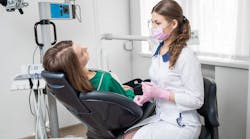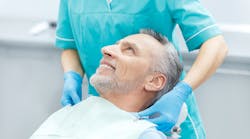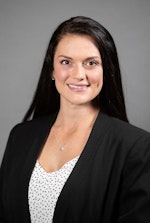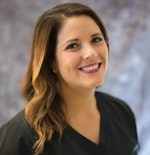Muted by our mask: The importance of nonverbal communication and patient interaction for dental hygienists
“Pardon me? I didn’t quite catch that.” Were you having to say this often when face coverings were mandated during the pandemic? Not seeing people’s lips directly interferes with the ability to understand them. Is this why patients always ask clinicians to repeat themselves?
Issues with hindered communication puts into perspective patients’ challenges when talking with masked health-care professionals. It’s also more challenging from a clinician's point of view to gauge patients' moods as they enter and leave the dental office. Not being able to interpret someone’s feelings makes it hard to connect and facilitate a pleasant experience. Increased mask use interferes with patient and clinician communication and connection.
Dental health-care professionals know that effective communication is paramount to building relationships with patients. Adequate communication helps build trust and understanding and ensures everyone is on the same page and working toward the same goals. Since the pandemic, the increased use of masks has hindered clinician/patient interpersonal connection during face-to-face communication.1
Dental team members have worn masks as an essential part of our personal protective equipment (PPE) for decades. However, the heightened mask requirements have stolen the smiles that were exchanged before and after treatment, requiring clinicians to find other ways to connect with patients. It’s reported that communication is received 7% verbally, 38% through vocal tone, and 55% through facial language.2 Therefore, by wearing a mask, 93% of the nonverbal conveyed delivery is now potentially missed by the receiver.
How to enhance nonverbal communication
Verbal communication consists of listening and speaking, while nonverbal communication includes expression and perception.3 Nonverbal communication is crucial for building patient rapport, trust, and credibility, which is the foundation of our patient connection.4 Clinicians can build these traits by showing empathy through facial expressions, such as smiling and frowning.3
The patient can miss a clinician’s intended empathy when mouth coverings hide expressions. According to peer-reviewed psychological, dental, and medical literature, empathy positively correlates with treatment planning, adherence, increased patient satisfaction, and reduced dental anxiety.5 Conveying empathy should be one of our primary goals. How do we do that?
Other ways to express yourself with patients
Luckily, we have other ways to express empathy. The mouth and eyes are vital to decoding that emotion. With the mouth covered, people now focus on the upper face, eyes, and eyebrows during a conversation. Eye gaze is a way for patients to know that a clinician is directly communicating with them.6 Raised eyebrows, which make eye gaze easier to see, have been found to make a person seem engaging and trustworthy. Likewise, widening the eyes can indicate interest, openness, and acknowledgment.6 Conversely, the eye region can express anger, question, concern, or surprise. Without seeing the lower part of the face, some expressions in the eye area can look similar to an opposite or unintended expression (figure 1).
In addition to upper facial expressions, clinicians should continue to use posture, tone of voice, active listening, and thoughtful responses to express themselves to patients. Posture can relay positive and negative emotions independent of facial expressions.3 Sitting at a patient's level expresses interest and connection. The tone of voice, including inflection, can affect how others perceive your words. Hearing the whole patient and active listening strengthens clarification and communication. Lastly, thoughtful responses build patient rapport and trust.3
In the past, a simple smile put patients at ease. Increased mask use is affecting patient/clinician connection. Masks block visual access to the mouth and obscure other facial cues, leading to communication difficulties. Upper facial movements and other forms of nonverbal communication are needed now more than ever to express compassion and connection.
Nonverbal skills are not typically taught in school or CE courses, leaving it up to clinicians to be aware of how their nonverbal communication, or lack thereof, can affect patient interaction and experiences. Nonverbal cues missed by patients can negatively affect their experiences. It’s our job as clinicians to prevent being muted by our masks.
Editor's note: This article appeared in the June 2024 print edition of RDH magazine. Dental hygienists in North America are eligible for a complimentary print subscription. Sign up here.
References
1. Mheidly N, Fares MY, Zalzale H, Fares J. Effect of face masks on interpersonal communication during the COVID-19 pandemic. Front Publ Health. 2020;8(1). doi:10.3389/fpubh.2020.582191
2. Amsel T. An urban legend called: The 7/38/55 Ratio Rule. Euro Polygraph. 2019;(13):95-99. doi:10.2478/ep-2019-0007
3. Riess H, Kraft-Todd G. E.M.P.A.T.H.Y. A tool to enhance nonverbal communication between clinicians and their patients. Academ Med. 2014;89(8):1108-1112. doi:10.1097/acm.0000000000000287
4. Nonverbal communication skills that affect presentations. American Management Association. January 24, 2019. Accessed January 1, 2024. https://www.amanet.org/articles/nonverbal-communication-skills-that-affect-presentations/
5. Jones LM, Huggins TJ. Empathy in the dentist-patient relationship: review and application. N Z Dent J. 2014;110(3):98-104. https://pubmed.ncbi.nlm.nih.gov/25265748/
6. Frith C. Role of facial expressions in social interactions. Philos Trans R Soc Lond B Biol Sci. 2009;364(1535):3453-3458. doi:10.1098/rstb.2009.0142











